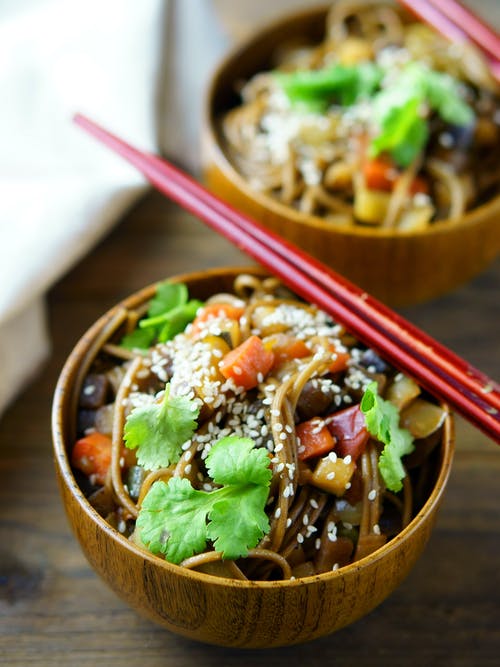Ayurveda says that digestion is the very core of our metabolism. It is the very gateway through which everything enters inside the body, whether is it nutrition or pathogens. Therefore, a person who wants healthy eating and Ayurveda diet to ensure a healthy and fruitful life must preserve his agni or the digestive fire.

According to Ayurveda diet, there are 13 different types of agni or 13 different levels of digestion that happen inside the body simultaneously. However, the most important of them all is the pachakagni or the primary digestive system. It includes the primary digestive organs like the stomach, intestines, liver, pancreas, etc.
Healthy Eating : The Ayurveda diet protocol
Ayurveda describes an elaborate meal protocol that consists of multiple sets of instructions. These are the rules that you should observe –
before a meal
during a meal
after a meal
These instructions help us to be in tune with the digestive biorhythm of the body and avoid disease-causing imbalance. Here is the most important instruction that you MUST follow before a meal
Pre-meal Ayurveda Diet Code –
The foundation idea for the pre-meal Ayurveda code is that the digestive system, in fact, the entire body should be prepared to receive and absorb the food. So, it is as important as preparing the home to receive an important guest! And definitely, food is that important. It is a source of life for us. And the best state, primary condition to eat food is – hunger!
Eat when hungry!
This is the most fundamental rule for an Ayurvedic meal. PLEASE DO NOT EAT IF YOU ARE NOT HUNGRY. Please do not treat your body like a dustbin. When we give more importance to our tongue, we are practically treating our bodies like a trash bin!

The logic is that when you are not hungry, it means that your body does not need food. It also means that your system is not prepared to handle the food. And it is actually hazardous to eat a little snack here and there, without proper hunger because when you are not hungry, your blood sugar is normal. But if you pour more sugar inside the body in the form of an unwanted snack, you create an undesired and unexpected sugar spike in the body. If this happens frequently, your body cells might get used to a pathogenic sugary environment. And this is the basic reason for sugar resistance inside the body, and obviously for diabetes.
And this is only one problem stated here. Think about all the unprepared digestive organs, suddenly exposed to a sudden sugar surge. Even according to modern science, high blood sugar is linked to most of the grave disorders like obesity, hormonal imbalance, health disorders, kidney damage, and so on.

Therefore, Ayurveda advises against adhyashana (eating before the previous meal is properly digested or without proper hunger).
But, with one single and simple habit of having a hunger based meal, you can cut the very roots of all these problems. This is the most fundamental pre-meal instruction for an Ayurveda follower – EAT ONLY WHEN HUNGRY.
Exceptions
However, it is important to note that this advice is applicable only to a healthy individual. It is esp. not applicable to eating disorders like anorexia, where a person might feel no hunger. It is best for you to visit an Ayurveda physician for personalized advice if you are suffering from a severe disorder.
Also, sometimes it is not practical to eat only when you are hungry. Sometimes, you have to rush to the office, or to school. There can be unexpected engagement that might ruin your meal plans. But Ayurveda has a remedy for everything. In such cases, you can create hunger!
Create the hunger!
If we are not hungry, we can create the hunger to avoid all the unhealthy consequences of a hunger-less meal. And Ayurveda suggests use of digestives in such cases.
Digestives are a very important branch in kaya chikitsa(Ayurvedic general medicine). A digestive suitable to your body type can help you digest the previous meal faster and also rekindle fresh hunger.
However, these digestives should be used with care and thoughtfulness. Ideally, they should be used once before every meal.
Excessive or incompatible use of digestives can imbalance pitta and vata dosha. It might also lead to early aging, excessive hair fall, dryness in skin, bloating, acidity, and many more problems.
Here I have described a simple digestive recipe described in classical Ayurvedic texts (bhaishajya kalpana etc.). This remedy is harmless and can be safely used for the long term.
Ayurveda Diet: Fried Ginger Flakes
Preparation:
1. Take 100 gm of fresh ginger root and clean it properly.
2. It is good to choose ginger which has almost even thickness.
3. Slice the ginger root into thin flakes.
4. The flakes should be thick enough so that they do not burn while frying.
5. Take 50 gm ghee or Indian butter and heat it on slow flame. It should be hot enough for frying.
6. Vegans can choose different oils according to their body type, however, pure sesame oil is good for everyone.
7. Avoid very hot ghee/oil, otherwise, the flakes might burn before getting properly fried.
8. Fry the ginger flakes on a slow flame, till the raw aroma subsides.
9. Let the flakes cool to normal temperature.
10. Add little pink salt (2-3 pinches maximum) and store it in a glass bottle. Keep them soaked in the leftover ghee/oil.
This recipe should not be stored in the refrigerator. However, it can be safely stored at room temperature for a minimum of a month, depending on your climatic conditions.
Usage:
Day 1:
Start with a single flake.
Gradually chew the flake, 20-25 min before the meal.
Day 2 and more:
Observe your body response and slowly increase the dosage according to your body requirements.
If the mealtime is unexpected, eat the flake just before the meal.
Precautions
Avoid using burnt ginger flakes as they might create digestive issues.
Pink salt is a part of the digestive remedy and is not meant for flavor. Therefore add only in small quantity.
Avoid using this remedy more than 2-3 times a day.
Avoid using the remedy if you have sharp hunger pangs (pitta prakrati).
Avoid using the remedy if you are already hungry and not going to eat immediately.
Kapha prakrati people might need more quantity as compared to pitta prakrati people.
Discontinue the remedy if you feel any discomfort.
Please contact your physician before using any home remedy.
I hope that this article helps us to respect our metabolic biorhythm and live in harmony with it!
This article was about pre-meal Ayurveda diet rules for a healthy digestive system and to find out how we should have the three meals of the day. read our next article (Healthy Meal Plans | Ideal Ayurvedic Diet – Part II)
